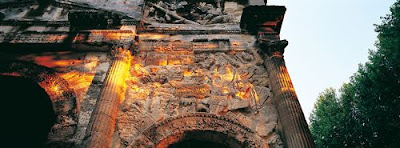Orange (Provençal Occitan: Aurenja in classical norm or Aurenjo in Mistralian norm) is a commune in the Vaucluse department in the Provence-Alpes-Côte d'Azur region in southeastern France
It has a primarily agricultural economy. It is located about 21 km north of Avignon
History
Roman Orange was founded in 35 BC by veterans of the Second legion as Arausio (after the local Celtic water god), or Colonia Julia Firma Secundanorum Arausio in full, "the Julian colony of Arausio established by the soldiers of the second legion." The name was originally unrelated to that of the orange fruit (Sanskrit nāraṅgaḥ), but was later conflated with it.
A previous Celtic settlement with that name existed in the same place and a major battle, which is generally known as the Battle of Arausio, had been fought in 105 BC between two Roman armies and the Cimbri and Teutones tribes.
Arausio covered an area of some 170 acres (69 ha) and was well endowed with civic monuments - as well as the theatre and arch, it had a monumental temple complex and a forum.
It was the capital of a wide area of northern Provence Orange of two thousand years ago was a miniature Rome , complete with many of the public buildings that would have been familiar to a citizen of the Roman Empire , except that the scale of the buildings had been reduced -- a smaller theater to accommodate a smaller population, for example."
The town prospered. It was sacked by the Visigoths in 412. It became a bishopric in the fourth century, and the hill fort of the Celtic Cavares was renamed for Saint Eutrope, the first bishop of Saintes. Christian Orange hosted two synods, in 441 and 529. The latter of the Councils of Orange was of importance in condemning the Pelagian heresy. The Diocese of Orange persisted until the French Revolution, and was formally suppressed in 1801.
The sovereign Carolingian counts of Orange Orange became fully independent with the breakup of the Kingdom of Arles Orange was raised to a minor principality, the Principality of Orange, as a fief of the Holy Roman Empire . During this period the town and the principality of Orange belonged to the administration and province of Dauphiné
When William the Silent, count of Nassau , with estates in the Netherlands Spain Delft Netherlands England as William III of England Orange gave its name to other Dutch-influenced parts of the world, such as the Orange Free State in South Africa
The city remained part of scattered Nassau holdings until it was captured by the forces of Louis XIV in 1672 during the Franco-Dutch War, again captured in August 1682 and was finally ceded to France in 1713 under the Treaty of Utrecht that ended the wars of Louis XIV. Following the French Revolution of 1789, Orange
Main sights
The town is renowned for its Roman architecture and its Roman theatre is described as the most impressive still existing in Europe . The fine Triumphal Arch of Orange is often said to date from the time of Augustus or Tiberius, but is probably much later, perhaps Severan. The arch, theatre and surroundings were listed in 1981 by UNESCO as a World Heritage Site.
The Musée (Museum) displays the biggest (7.56 x 5.90 m) cadastral Roman maps ever recovered, etched on marble. They cover the area between Orange
Culture
In 1869, the Roman theatre was restored and has been the site of a music festival. The festival, given the name Chorégies d'Orange in 1902 has existed annually ever since, and is now famous as an international opera festival.
In 1971, the "New Chorégies" were started and became an overnight, international success. Many top international opera singers have performed in the theatre, such as Barbara Hendricks, Plácido Domingo, Montserrat Caballé, Roberto Alagna, René Pape and Inva Mula. Operas such as Tosca, Aida, Faust and Carmen have been staged here, many with a sumptuous staging and also receiving outstanding acclaim.
The Roman theatre is one of three heritages still having the Roman Wall.



















Niciun comentariu:
Trimiteți un comentariu